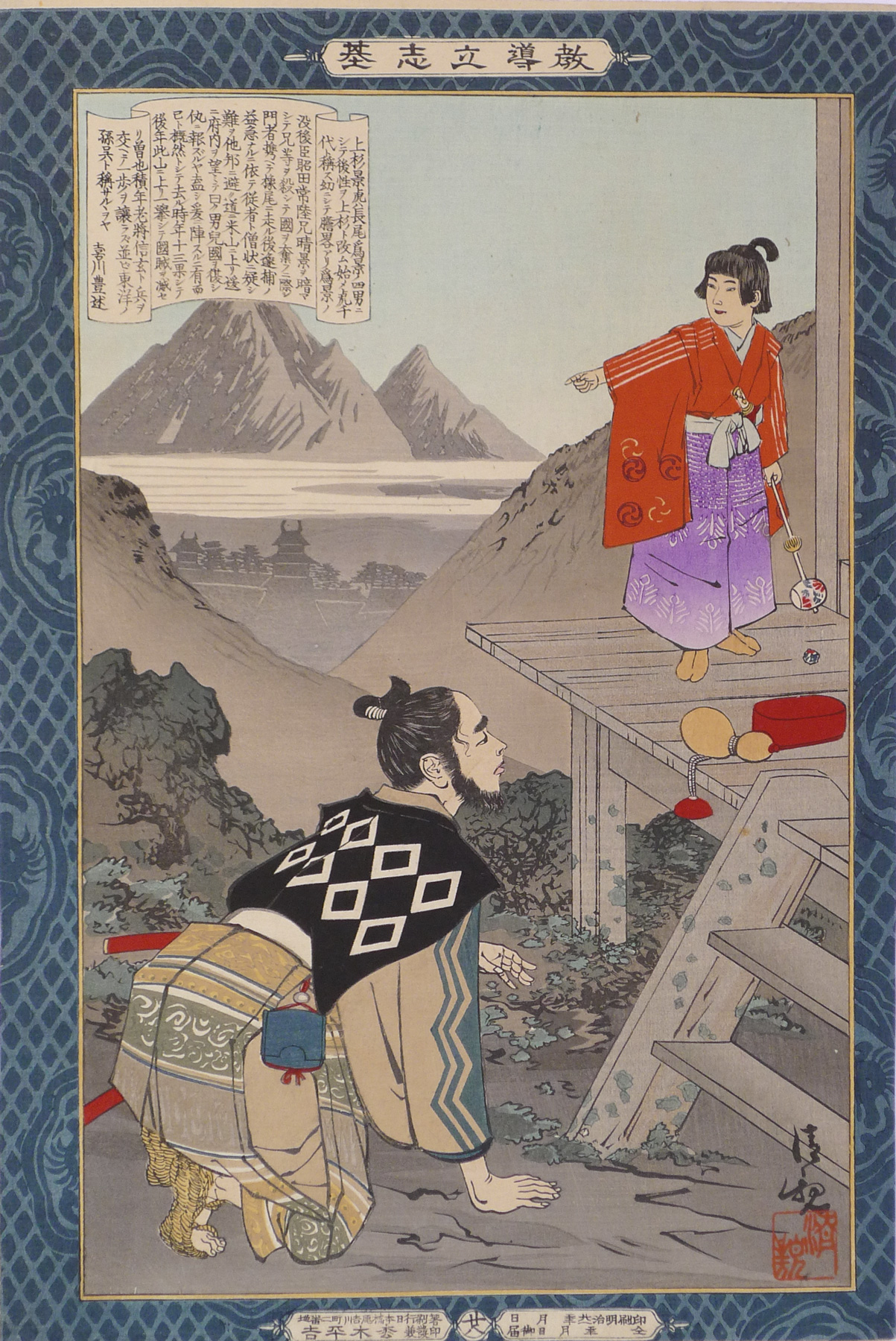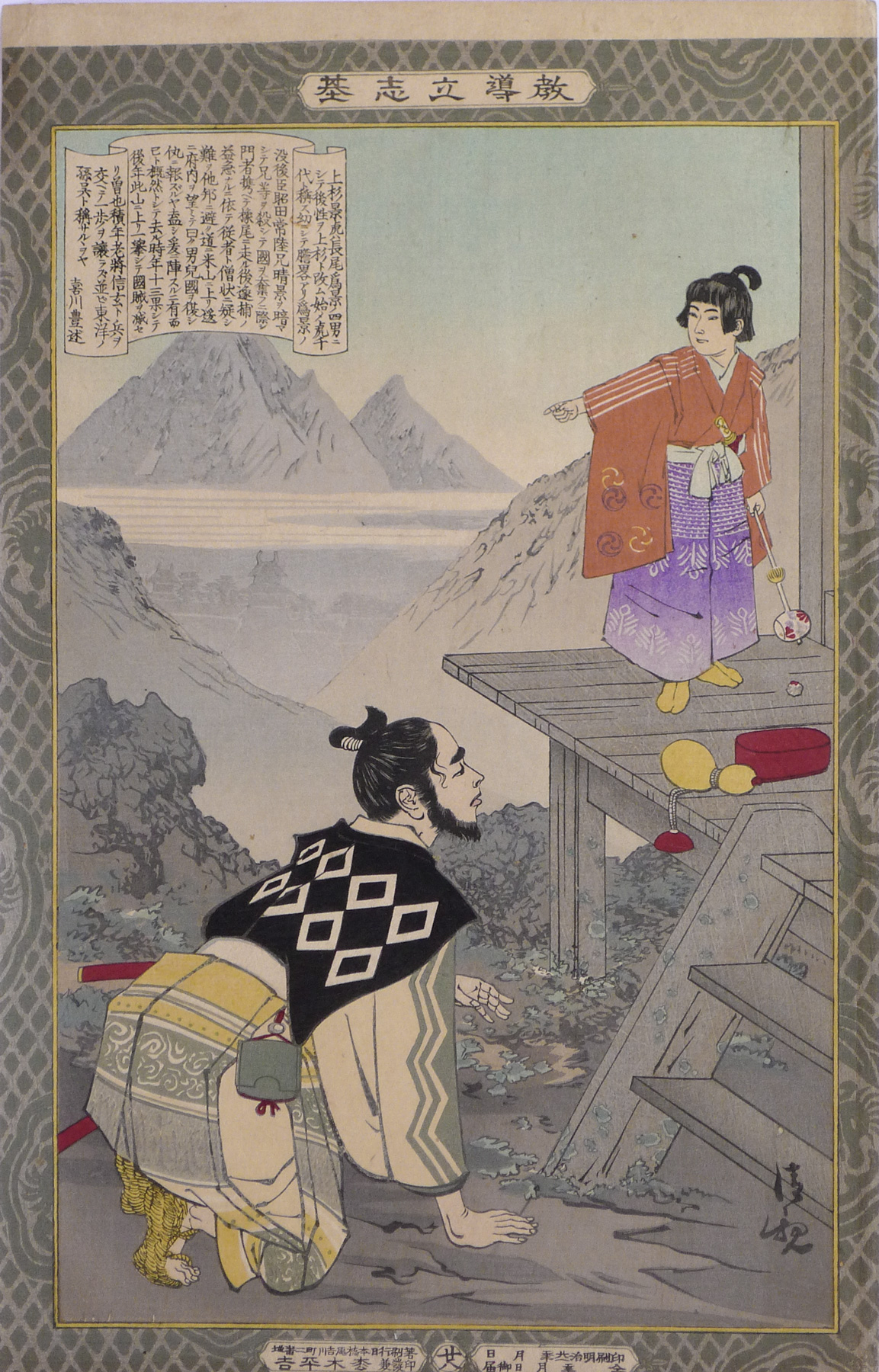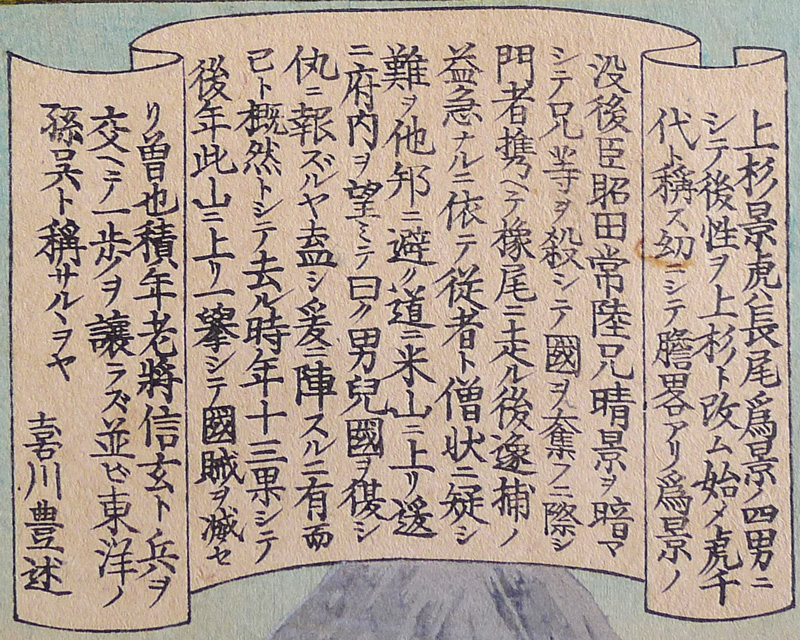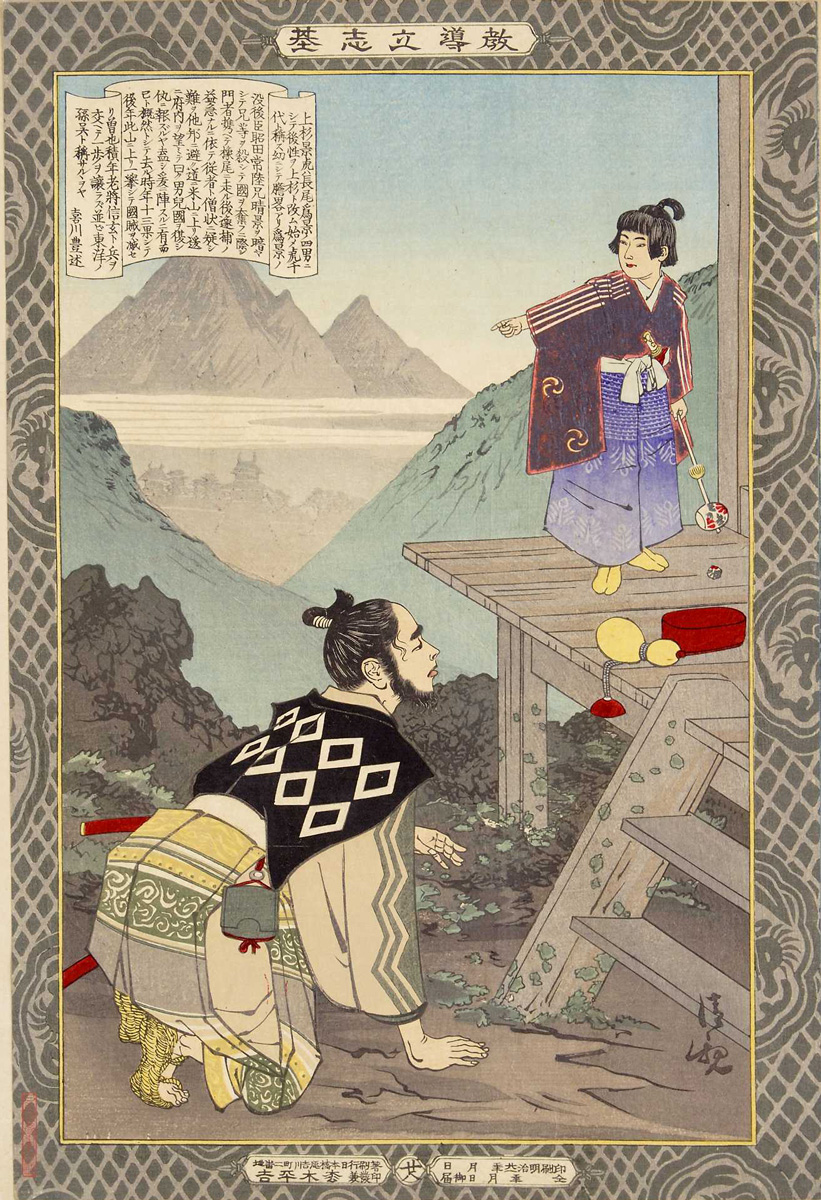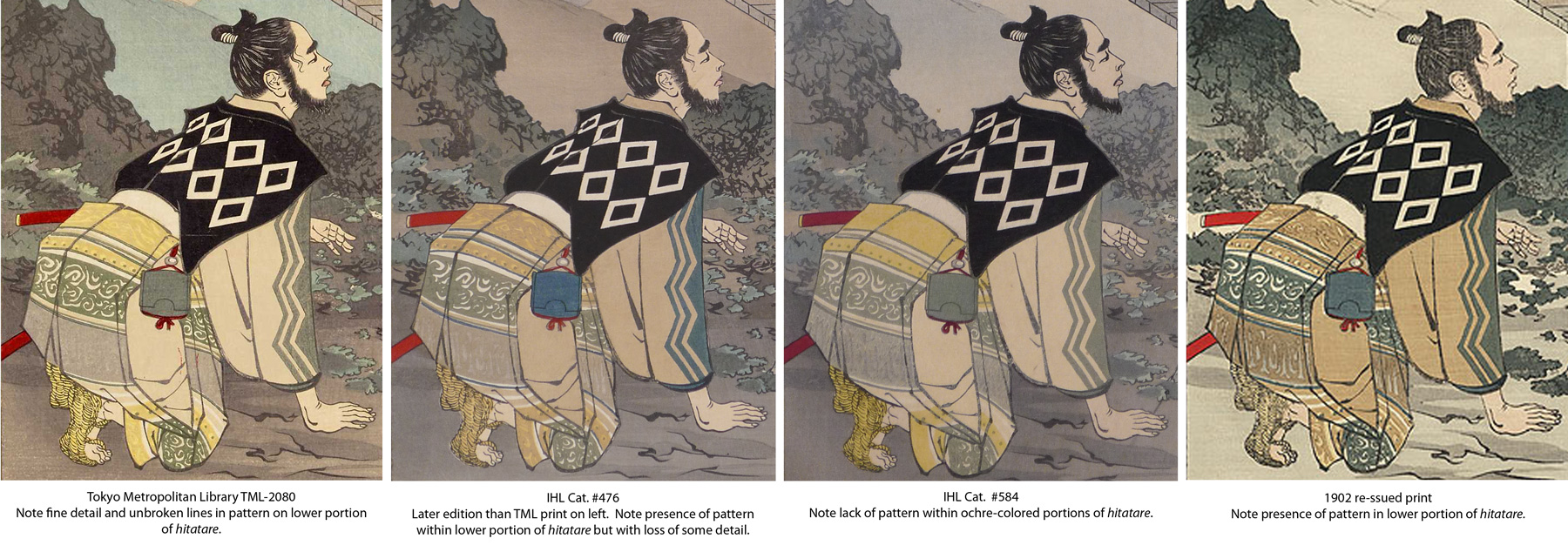About This Print
Print number 廿八 (28)1 in the series Instructive Models of Lofty Ambition picturing a young Uesugi Kagetora with a croquet mallet in hand instructing a young samurai.Kiyochika contributed 20 prints to this series. As Smith states: "Thestyle of Kiyochika’s offerings to Instructive Models of LoftyAmbition was decorous and even stiff, as befitted the didacticemphasis of the whole [series.]"2
1 Numbering of the prints was haphazard during the production of the series. Print numbers were sometimes inadvertently omitted; some prints in the series were never assigned numbers and a few of the same numbers appear on different prints.
2 Kiyochika Artist of Meiji Japan, Henry D. Smith II, Santa Barbara Museum of Art, 1988, p. 74.
A Confusion of Names
It is unclear to me, based upon the limited research I've conducted, whether this print is picturing Uesugi Kagetora 上杉 景虎 or Uesugi Kenshin 上杉 謙信, or whether they are one in the same. A full translation of the scroll, a transcription of which is provided below, might clear up this confusion.The Prints Scroll
The top four characters in the right hand column of the scroll-like cartouche, which is transcribed below, read 上杉景虎, the kanji characters for the historical figure Uesugi Kagetora. The scroll goes on to say that Uesugi Kagetora (上杉景虎) is the fourth son (四男) of Nagao Tamekage (長尾為景).
Tokyo Metropolitan Library Assigned Print Title
The Tokyo Metropolitan Library gives the title of this print as 上杉 虎千代, the kanji characters for the historical figure Uesugi Torachiyo.1 Torachiyo, according to the website The Samurai Archives2, was the childhood name of Uesugi Kenshin. (However, other sources say Kagetora was the childhood name of Uesugi Kenshin.)
Wiki Entries on Uesugi Kagetora and Uesugi Kenshi
The wikipedia entry for Uesugi Kagetora3 (上杉 景虎, 1552 – April 19, 1579) relates that he was the seventh son of Hōjō Ujiyasu and he he was adopted by Uesugi Kenshin (上杉 謙信, February 18, 1530 – April 19, 1578) and was meant to be Kenshin's heir.
The wikipedia entry for Uesugi Kenshin4 上杉 謙信, says his original name was Nagao Kagetora (長尾景虎). It goes on to say that he was born the fourth son of the noted warrior Nagao Tamekage (長尾為景). He changed his name to Uesugi Masatora (上杉政虎) when he inherited the Uesugi family name in order to accept the official title of Kantō Kanrei (関東管領). Later he changed his name again to Uesugi Terutora (上杉輝虎) to honor the Shogun Ashikaga Yoshiteru (足利義輝), and finally to Kenshin (上杉謙信) after he became a Buddhist monk.
An entry from the gaming website Koei5 wikia gives the following information on Kenshin:
When Kenshin was born, his name was Torachiyo (虎千代). His name after his coming of age ceremony became Nagao Kagetora (長尾景虎). He changed his name to Uesugi Masatora (上杉政虎) when he inherited the Uesugi family name in order to accept the official title of Kantō Kanrei. Later he changed his name again to Uesugi Terutora (上杉輝虎) to honor the shogun Ashikaga Yoshiteru, and finally to Fushigian Kenshin (不識庵謙信) after he became a Buddhist monk.
Uesugi Kagetora according to Stephen Turnbull
The following information is taken from Stephen Turnbull's book Kawanakajima 1553-1564: Samurai Power Struggle6.
“Tamekage, [an early to mid-16th century daimyo], left four sons, Harukage, Kageyasu, Kagefusa and Kagetora. Kagetora was the youngest of the four. On their father’s death, Harukage became head of the family, but his health was poor and he showed little ability for government. His brothers were commendably loyal to him, however, as the whole family were to their Uesugi overlords. When young Kagetora was 15, Harukage placed him in joint command of Tochio castle, along with Honjo Saneyori, where they were attacked by anti-Uesugi rebels but soundly defeated them. This early military experience earned young Kagetora a reputation akin to that of the young Shingen [another daimyo of the period.]"
1 http://metro.tokyo.opac.jp/tml/tpic/cgi-bin/detail.cgi?Kbseqid=8848&Sryparam=001&Backpage=/tml/tpic/resprint_d/2011/10/25/5812_001_001.html&Srhfname=/resprint_d/2011/10/25/5812&Rp_kind=1&Prtype=&Displmt=30
2 http://www.samurai-archives.com/names.html
3 http://en.wikipedia.org/wiki/Uesugi_Kagetora
4 http://en.wikipedia.org/wiki/Uesugi_Kenshin
5 http://koei.wikia.com/wiki/Kenshin_Uesugi
6 Kawanakajima 1553-1564: Samurai Power Struggle, Stephen Turnbull, Osprey Publishing, 2003, p. 16-17.
Transcription of Scroll
click on scroll detail for enlargement
Source: with thanks to Yajifun http://yajifun.tumblr.com/28 Uesugi Torachiyo (Kenshin) 上杉虎千代(謙信)
教導立志基 廿八 上杉虎千代 小林清親 1888年
Transcription: [scroll text by 喜川豊]
“上杉景虎ハ長尾為景ノ四男ニシテ後性ヲ上杉ト改ム 始メ虎千代ト稱ス 幼ニシテ膽略アリ 為景ノ没後臣昭田常陸兄晴景ヲ暗マシテ兄等ヲ殺シテ國ヲ奪フニ際シ門者携ヘテ橡尾ニ走ル 後?捕(逮捕?)ノ益急ナルニ依テ従者ト僧状ニ疑シ難ヲ他邦ニ避ク 道ニ米山ニ上リ?(遥?)ニ府内ヲ望ミテ曰ク 男兒國ヲ復シ仇ニ報ズルヤ蓋シ爰ニ陣スルニ有而已 ト概然トシテ去ル 時年十三 果シテ後年此山ニ上リ一擧シテ國賊ヲ滅セリ 曽也積年老将信玄ト兵ヲ交ヘテ一歩ヲ譲ラズ並ビ東洋ノ孫呉ト稱サルゝヲヤ 喜川豊 述”
Variant Edition and Later Reissue with Border Removed
| variant version (note color variation and absence of artist's seal below signature) Tokyo Metropolitan Library 280-K010 | 1902 reissue |
Comparison of four printings
click on image for detail
click on image for detail
About The Series "Kyōdō risshi no motoi"
Notes:
This series ran between October 1885 and November 1890 and featured a long list of heroes and heroines, from antiquity to contemporary times, who were regarded as standards of moral leadership and self-realization.
Brief texts contained within a scroll-like cartouche appearing on each print provide historical details. The scroll composer's name is given at the end of the scroll text. The “lofty ambition” of the title is a Confucian concept, originally from Mencius, meaning “righteous determination that would inspire others.” The market for the series probably included former samurai, ambitious youth, and conservative intellectuals.
"[W]hen it was completed in 1890 the publisher was singled out for special recognition by the government for having sponsored such noble subject matter."3
1 The Tokyo Metropolitan Library online collection shows 50 prints and a Table of Contents sheet. The Table of Contents lists the titles of 50 prints. Smith in Kiyochika Artist of Meiji Japan identified 52 prints. I have identified 58 prints from this series including five prints (Ikina, Michizane Sugiwara, Kesa Gozen, Soga Brothers and Hokiichi Hanawa) that were re-designed and re-printed, likely due to damaged or lost blocks.
2 Robert Schaap notes in Appendix II, p. 166 of Yoshitoshi, Masterpieces from the Ed Freis Collection, Chris Uhlenbeck and Amy Reigle Newland, Hotei Publishing, 2011 that the series originally appeared as newspaper supplements.
3 The World of the Meiji Print: Impressions of a New Civilization, Julia Meech-Pekarik, Weatherhill, 1986, p. 122.
1. This series is variously translated as "Instructive Models of Lofty Ambition," "Foundations of Learning and Achievement," "Foundation of Instruction and Perseverance," "Self-Made Men Worthy of Emulation," "Paragons of Instruction and Success," "Moral of Success," "Examples of Self-Made Leaders," and "Instruction in the Fundamentals of Success." The title in Japanese is sometimes seen as "Kyōdō risshiki or "Kyōdō risshi no moto," in addition to the most commonly seen transliteration of "Kyōdō risshi no motoi".
2. For a complete listing of all the prints in the series and additional information please see the article on this site titled Instructive Models of Lofty Ambition.
This series ran between October 1885 and November 1890 and featured a long list of heroes and heroines, from antiquity to contemporary times, who were regarded as standards of moral leadership and self-realization.
Source: Kiyochika Artist of Meiji Japan, Henry D. Smith II, Santa Barbara Museum of Art, 1988, p. 74-75; original research and as footnoted.
This series of 58 prints,1 plus a table of contents sheet (目録), were originally published between October 1885 and November 1890 by the Tokyo publisher Matsuki Heikichi 松木平吉.2 The table of contents sheet issued by the publisher states that "fifty prints make up the complete set (五十番揃)". Three prints not in the initial release were added over the five year publication period, as were five redesigns of original prints, eventually increasing the total print count to 58. The seven artists contributing prints were Kobayashi Kiyochika (1847-1915) [20 prints], Mizuno Toshikata (1866-1908) [16 prints], Inoue Tankei (Yasuji) (1864-1889) [13 prints], Taiso (Tsukioka) Yoshitoshi (1839-1892) [5 prints], Yōshū Chikanobu (1838-1912) [2 prints], Toyohara Kunichika (1835–1900) [1 print], and Hachisuka (Utagawa) Kuniaki II (1835-1888) [1 print]. All the artists, with the exception of Yōshū Chikanobu, are listed in the top scroll of the table of contents sheet. Various colors (including blue, blue/green, and tan/brown) were used for the decorative border, and in 1902 the series was re-issued by Matsuki without borders.
This series of 58 prints,1 plus a table of contents sheet (目録), were originally published between October 1885 and November 1890 by the Tokyo publisher Matsuki Heikichi 松木平吉.2 The table of contents sheet issued by the publisher states that "fifty prints make up the complete set (五十番揃)". Three prints not in the initial release were added over the five year publication period, as were five redesigns of original prints, eventually increasing the total print count to 58. The seven artists contributing prints were Kobayashi Kiyochika (1847-1915) [20 prints], Mizuno Toshikata (1866-1908) [16 prints], Inoue Tankei (Yasuji) (1864-1889) [13 prints], Taiso (Tsukioka) Yoshitoshi (1839-1892) [5 prints], Yōshū Chikanobu (1838-1912) [2 prints], Toyohara Kunichika (1835–1900) [1 print], and Hachisuka (Utagawa) Kuniaki II (1835-1888) [1 print]. All the artists, with the exception of Yōshū Chikanobu, are listed in the top scroll of the table of contents sheet. Various colors (including blue, blue/green, and tan/brown) were used for the decorative border, and in 1902 the series was re-issued by Matsuki without borders.
Brief texts contained within a scroll-like cartouche appearing on each print provide historical details. The scroll composer's name is given at the end of the scroll text. The “lofty ambition” of the title is a Confucian concept, originally from Mencius, meaning “righteous determination that would inspire others.” The market for the series probably included former samurai, ambitious youth, and conservative intellectuals.
"[W]hen it was completed in 1890 the publisher was singled out for special recognition by the government for having sponsored such noble subject matter."3
1 The Tokyo Metropolitan Library online collection shows 50 prints and a Table of Contents sheet. The Table of Contents lists the titles of 50 prints. Smith in Kiyochika Artist of Meiji Japan identified 52 prints. I have identified 58 prints from this series including five prints (Ikina, Michizane Sugiwara, Kesa Gozen, Soga Brothers and Hokiichi Hanawa) that were re-designed and re-printed, likely due to damaged or lost blocks.
2 Robert Schaap notes in Appendix II, p. 166 of Yoshitoshi, Masterpieces from the Ed Freis Collection, Chris Uhlenbeck and Amy Reigle Newland, Hotei Publishing, 2011 that the series originally appeared as newspaper supplements.
3 The World of the Meiji Print: Impressions of a New Civilization, Julia Meech-Pekarik, Weatherhill, 1986, p. 122.
Print Details
| IHL Catalog | #476 and #584 | ||
| Title or Description | Uesugi Kagetora 上杉景虎 | ||
| Series | “Instructive Models of Lofty Ambition” (Kyodo risshiki 教導立志基) [note: seriestitle also listed as 'Kyodo Risshi no Moto', ‘Kyodo risshi no motoi’,‘Kyōdō risshi ki’ and variously translated as “Moral of success” or“Foundations of learning and achievement” or “Self-made Men Worthy ofEmulation”' or “Examples of Self-made Leaders” or "Paragons of instruction and success"] | ||
| Artist | Kiyochika Kobayashi (1847-1915) | ||
| Signature |
| ||
| Seal | Kiyochika 清親 below signature on IHL Cat. #476 no seal on IHL Cat. #584 | ||
| Publication Date | 1888 明治廿ー年 | ||
| Publisher | Matsuki Heikichi (松木平吉) proprietor of Daikokuya Heikichi [Marks: seal not shown; pub. ref. 029] IHL Cat. #476 IHL Cat. #584 (from right to left) printing and publishing: 印刷 明治廿ー年 月 日 仝年月 日 御届 [printing Meiji 21; notification delivered, Meiji 21 ] assigned number within series: 廿八 [28] publisher information: 著刷行 日本橋区 吉川町二番地 印發兼 松木平吉 [publisher and printer Nihonbashi district Ryōgoku Yoshikawachō 2-banchi Matsuki Heikichi] | ||
| Impression | excellent | ||
| Colors | excellent | ||
| Condition | good - Japanese album backing paper; very minor marks and flaws; borders slightly trimmed | ||
| Genre | ukiyo-e; rishki-e; kyōiku nishiki-e | ||
| Miscellaneous | print number 28 (廿八); position 28 in the Table of Contents for the series | ||
| Format | vertical oban | ||
| H x W Paper | 13 3/4 x 9 1/4 in. (34.9 x 23.5 cm) | ||
| H x W Image | 12 1/2 x 8 1/4 in. (31.8 x 21 cm) area inside brocade border | ||
| Literature | |||
| Collections This Print | Scripps College 2001.2.86; Tokyo Metropolitan Library 280-K010 (variant edition, see above) |


